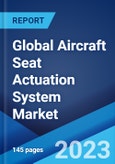Aircraft seat actuation systems provide comfort and safety to passengers and pilots. They assist in optimizing weight, kinetics, and intelligence, and providing smooth, ergonomic seat motion. They also aid in improving connectivity for passengers and pilots and offering higher performance and smart maintenance concepts. They comprise electronic control units, linear and rotary actuators, passenger seat control units, wiring harnesses, and lumbar massage systems. As aircraft seat actuation systems are light, silent, reliable, compact, and customizable, their demand is escalating around the world.
Aircraft Seat Actuation System Market Trends
Due to inflating disposable incomes, there is a significant increase in premium air travel worldwide. This, in confluence with the flourishing aviation industry, represents one of the key factors strengthening the market growth. Apart from this, the growing need for maintenance and retrofitting of existing aircraft is also driving the market. Moreover, the increasing procurement of commercial and military aircraft across the globe is offering lucrative growth opportunities to leading market players. Furthermore, aircraft manufacturers are extensively investing in research and development (R&D) activities to enhance the efficiency, size, and intelligence of aircraft seat actuation systems and ensure a comfortable and luxurious flying experience for passengers. They are also focusing on reducing the basic operating empty weight (OEW) of the aerial vehicle by using lightweight equipment and furniture. This, along with technological advancements, such as 3D printing and fiber-reinforced composites to make lighter and cost-effective seat actuators, is impelling the growth of the market. Other major factors, including the rising demand for lightweight cabin products and the growing number of low-cost airlines, are anticipated to impel the market growth in the coming years.Key Market Segmentation
This research provides an analysis of the key trends in each sub-segment of the global aircraft seat actuation system market report, along with forecasts at the global, regional and country level from 2023-2028. The report has categorized the market based on type, seat class, mechanism, component, aircraft type and end use.Breakup by Type:
- Electro-Mechanical
- Hydraulic
- Pneumatic
Breakup by Seat Class:
- Business Class
- Economy Class
- Premium Economy Class
- First Class
Breakup by Mechanism:
- Linear
- Rotary
Breakup by Component:
- Hardware
- Actuator
- In-seat Power Supply
- Passenger Control Unit
- Electronic Control Unit
- Software
Breakup by Aircraft Type:
- Narrow Body Aircraft (NBA)
- Wide Body Aircraft (WBA)
- Very Large Aircraft (VLA)
- Regional Transport Aircraft (RTA)
Breakup by End Use:
- Original Equipment Manufacturer (OEM)
- Aftermarket
Breakup by Region:
- North America
- United States
- Canada
- Asia-Pacific
- China
- Japan
- India
- South Korea
- Australia
- Indonesia
- Europe
- Germany
- France
- United Kingdom
- Italy
- Spain
- Russia
- Latin America
- Brazil
- Mexico
- Middle East and Africa
Competitive Landscape
The competitive landscape of the industry has also been examined along with the profiles of the key players being Astronics Corporation, Bühler Motor GmbH, Collins Aerospace (Raytheon Technologies Corporation), Crane Aerospace & Electronics (Crane Co.), Kyntronics, Mesag System AG, Moog Inc., NOOK Industries INC., Rollon S.p.A. and Safran.Key Questions Answered in This Report
1. What was the size of the global aircraft seat actuation system market in 2022?2. What is the expected growth rate of the global aircraft seat actuation system market during 2023-2028?
3. What are the key factors driving the global aircraft seat actuation system market?
4. What has been the impact of COVID-19 on the global aircraft seat actuation system market?
5. What is the breakup of the global aircraft seat actuation system market based on the type?
6. What is the breakup of the global aircraft seat actuation system market based on the seat class?
7. What is the breakup of the global aircraft seat actuation system market based on the mechanism?
8. What is the breakup of the global aircraft seat actuation system market based on the component?
9. What is the breakup of the global aircraft seat actuation system market based on the aircraft type?
10. What is the breakup of the global aircraft seat actuation system market based on the end use?
11. What are the key regions in the global aircraft seat actuation system market?
12. Who are the key players/companies in the global aircraft seat actuation system market?
Table of Contents
Companies Mentioned
- Astronics Corporation
- Bühler Motor GmbH
- Collins Aerospace (Raytheon Technologies Corporation)
- Crane Aerospace & Electronics (Crane Co.)
- Kyntronics
- Mesag System AG
- Moog Inc.
- NOOK Industries INC.
- Rollon S.p.A.
- Safran.
Methodology

LOADING...
Table Information
| Report Attribute | Details |
|---|---|
| No. of Pages | 145 |
| Published | November 2023 |
| Forecast Period | 2022 - 2028 |
| Estimated Market Value ( USD | $ 704.3 Million |
| Forecasted Market Value ( USD | $ 1118 Million |
| Compound Annual Growth Rate | 8.0% |
| Regions Covered | Global |
| No. of Companies Mentioned | 10 |









